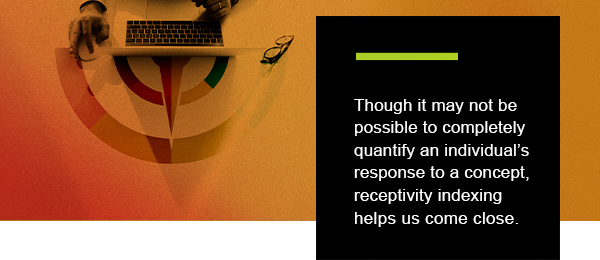At-a-Glance:
- Receptivity indexing is a method of measuring a product or services’ potential success at retail.
- Receptivity indexing studies rate concepts according to their appeal, believability, relevance and uniqueness
- Use receptivity data to course-correct product development or messaging strategies before you go to market
What is Receptivity Indexing?
What do you do when you think you have the next million-dollar idea, but want to be sure? Product development, manufacturing and merchandising are big investments — and throwing good money after bad ideas can jeopardize your business. Fortunately, a research methodology called receptivity indexing can help brands predict the potential success of a new product or service.
Sometimes called “concept testing” or “concept indexing,” receptivity indexing allows researchers to quantify your audience's response to your new product or line extension. The data you gather can provide critical direction for your concept development, messaging strategy and more.
How does receptivity indexing work?
Real-life purchasing decisions are usually multi-factored and complex. Methodical receptivity testing goes beyond simply asking respondents whether or not they would consider buying a product to gain deeper insights into what is spurring them on — and what may be holding them back.
Though it may not be possible to completely quantify an individual’s response to a concept, receptivity indexing helps us come close. In order to evaluate the strength of a concept, researchers look at four standard measures:
Appeal.
Researchers will ask respondents to rate how much they feel drawn to your idea. Depending on your category, your audience may find your product interesting, attractive, fun or time-saving.
Believability.
Some products seem too good to be true. This measure examines how readily your audience accepts that your product will live up to its claims.
Relevance.
Will your concept resonate with your target audience, or is it niche? Relevance measures whether or not potential buyers feel that your product has a place in their daily lives.
Uniqueness.
Is your idea innovative? This measure determines whether your products address a real, unmet need for your audience.
During a receptivity indexing study, respondents are asked to evaluate these four measures separately, rating each on a scale of 1-9, with 9 indicating that an idea is completely appealing, believable, relevant or unique. The receptivity index measures the number of respondents that give each measure an 8 or 9, which sets a much higher bar than simply looking at each measure monadically.

What makes a concept strong?
In general, a strong concept will show that 30-40% of respondents rate each individual measure at an 8 or 9.
Of course, there are exceptions to every rule. The nature of particular products and categories can move the goalpost for particular metrics. For example, a brand that produces electronics will probably have a lot more latitude for innovation than one that makes shovels — a consumer research agency with experience in your specific category can help you make a more relevant interpretation of your receptivity data.
Similarly, it only makes sense that ratings of relevance will vary considerably depending on whether or not you’re addressing your target audience. A brand that manufactures products that are very niche, expensive or geared toward professionals will have a much narrower audience than one that sells dryer sheets or toilet paper.
To get meaningful results from a receptivity indexing study, it’s a good idea to conduct a behavioral segmentation study beforehand to determine your precise target audience. This will allow you to compare how well your concept performs with your prime prospects as compared to the general population.
How to Evaluate Receptivity Data
The results of a receptivity indexing study can reveal what aspects of your concept need to be refined before your launch — as well as when it’s time to go back to the drawing board entirely.
Notice if one of the four standard measures seems to be an outlier. Maybe respondents find your idea appealing, but too good to be true. Perhaps you haven’t explained what makes it different from a product they already own. This gives you an opportunity to explore whether the issue lies with the concept itself, or rather with the way you’ve presented it.
A consumer research agency can help you analyze your data in a way that is relevant to your goals, whether you want to offer a line extension, conquest customers or appeal to a different segment of consumers.
This up-front consumer research investment can help paint a clearer picture of your retail future and ensure the success of your launch.


